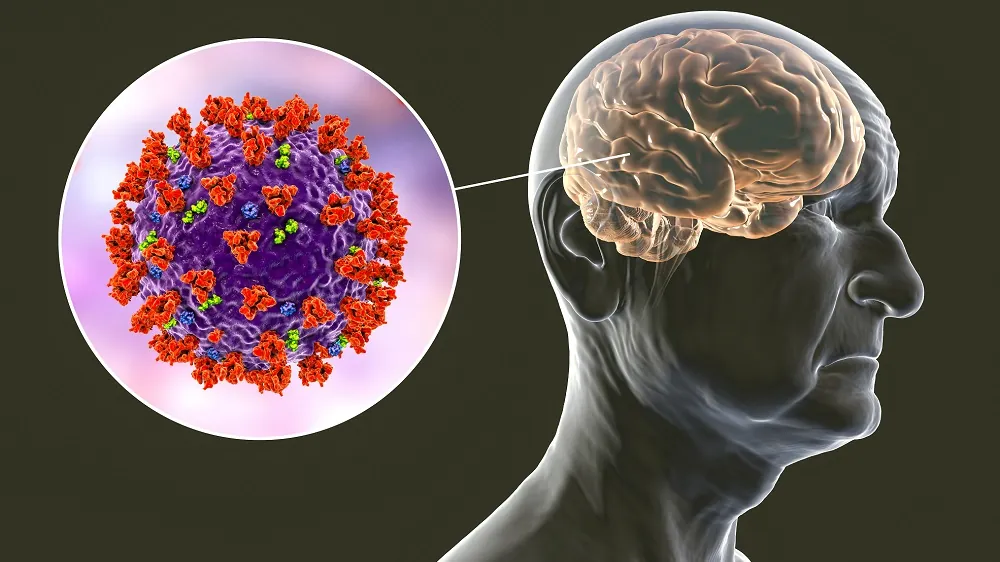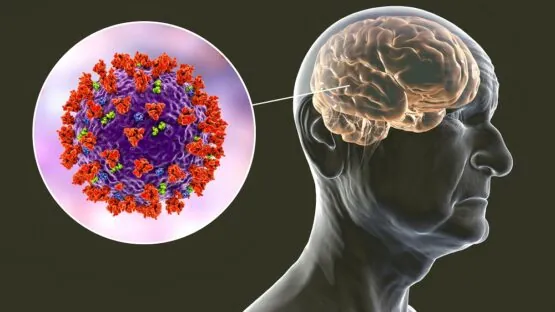A new publication in Nature Aging has used organoids and model mice to discover that senolytics may be effective treatments for neurodegeneration caused by long COVID.
A link between COVID-19 and cellular senescence
Post-acute infection syndromes (PAISes) are caused by a variety of viral and bacterial infections. The PAIS specific to the COVID-causing SARS-CoV-2, “long COVID”, is linked to multiple neurological problems, including fatigue and cognitive impairment [1]. Substantial evidence has found that SARS-CoV-2 invades the brain [2], and a study that used data from UK Biobank found that it is linked to changes in the brain’s structure [3].
The alterations linked to COVID are molecularly similar to brain aging [4]. As COVID-19 is also linked to cellular senescence in lung tissue [5], and senescent cells have been found to lead to neuropathology in the brain [6], these researchers developed a study to connect the two, attempting to determine the potential value of senolytics for treating long COVID’s effects on the brain.

Read More
Beginning with human organoids
The researchers began their investigation by using brain organoids, miniature organs grown for testing purposes from embryonic stem cells. After 8 months of natural aging, these organoids begin to develop significant cellular senescence. At this time, senolytic combinations were administered to various study groups.
In these organoids, astrocytes were more prone to senescence than neurons, but treating neurons was considerably more difficult. The well-known combination of dasatinib and quercetin was found to be the only senolytic that was effective at reducing the senescence marker p16 in neurons.
Interestingly, the various senolytics had different effects on the SASP-related mRNA expression of the cells in these organoids. For example, the laboratory senolytic ABT-737 reduced SERPINF1, while dasatinib and quercetin reduced SERPINE1 and IL1A instead. Overall, dasatinib and quercetin were found to be the best at reversing senescence-related gene expression.
After analyzing post-mortem brain tissue from both COVID-19 sufferers and age-matched controls that died of unrelated causes, the researchers found that the COVID group had substantially more markers of cellular senescence. They then infected brain organoids with various strains of SARS-CoV-2. Most of the variants significantly upregulated senescence markers along with the DNA damage biomarker γH2AX.
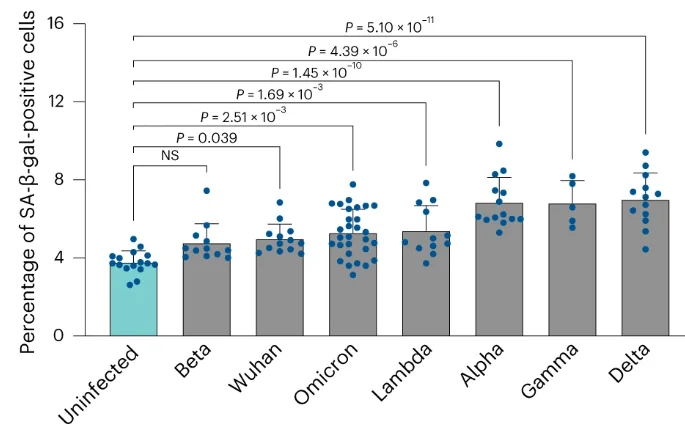
Over 30% of the gene expressions of these organoids that were changed with natural aging were also changed with SARS-CoV-2 infection. Many of the affected genes were part of known senescence pathways. The Delta variant had a uniquely strong effect on senescence-related gene expression. Senolytic treatment was found to substantially reduce senescence markers in infected organoids.
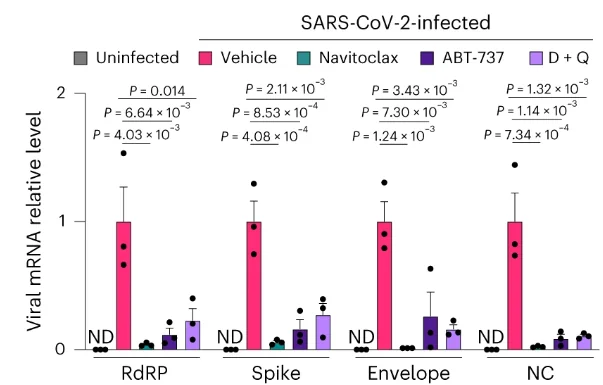
Mouse data agreed
As mice do not normally contract SARS-CoV-2, the researchers used a mouse model that expresses the human ACE2 protein that is a vector for the disease. One of the first and most startling findings was that senolytics reduced the mortality caused by this infection; after 10 days, all of the untreated mice were dead, but nearly half of the dasatinib and quercetin-treated mice were still alive after day 12. All of the tested senolytics also had substantial effects on the mice’s RNA gene expression, reducing inflammatory and senescence markers down nearly to the levels of uninfected controls.
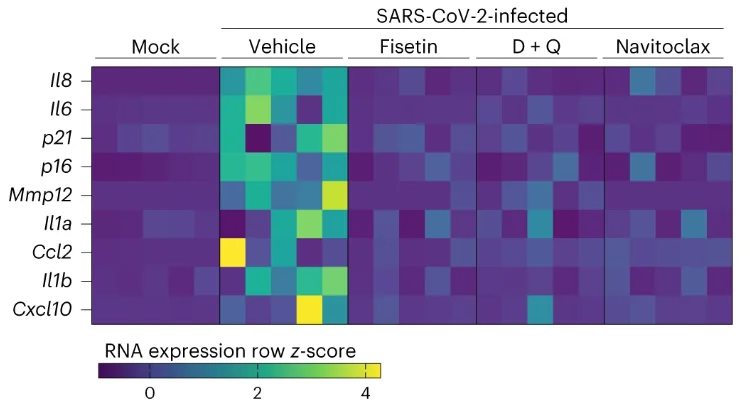
Additionally, all of the senolytics also reduced viral RNA related to viral replication. The researchers hypothesize that SARS-CoV-2 preferentially proliferates through senescent cells.
While it is still unclear if senolytics could be useful as COVID-19 treatments in people, this research points in that direction. Clinical trials would need to be conducted to determine if senolytics can reduce the infectivity of COVID-19, are effective against long COVID or other PAISes, or can ameliorate the symptoms of ordinary brain aging.
Literature
[1] Hartung, T. J., Neumann, C., Bahmer, T., Chaplinskaya-Sobol, I., Endres, M., Geritz, J., … & Finke, C. (2022). Fatigue and cognitive impairment after COVID-19: A prospective multicentre study. EClinicalMedicine, 53.
[2] Schwabenland, M., Salié, H., Tanevski, J., Killmer, S., Lago, M. S., Schlaak, A. E., … & Bengsch, B. (2021). Deep spatial profiling of human COVID-19 brains reveals neuroinflammation with distinct microanatomical microglia-T-cell interactions. Immunity, 54(7), 1594-1610.
[3] Douaud, G., Lee, S., Alfaro-Almagro, F., Arthofer, C., Wang, C., McCarthy, P., … & Smith, S. M. (2022). SARS-CoV-2 is associated with changes in brain structure in UK Biobank. Nature, 604(7907), 697-707.
[4] Mavrikaki, M., Lee, J. D., Solomon, I. H., & Slack, F. J. (2022). Severe COVID-19 is associated with molecular signatures of aging in the human brain. Nature Aging, 2(12), 1130-1137.
[5] Lee, S., Yu, Y., Trimpert, J., Benthani, F., Mairhofer, M., Richter-Pechanska, P., … & Schmitt, C. A. (2021). Virus-induced senescence is a driver and therapeutic target in COVID-19. Nature, 599(7884), 283-289.
[6] Ogrodnik, M., Evans, S. A., Fielder, E., Victorelli, S., Kruger, P., Salmonowicz, H., … & Jurk, D. (2021). Whole-body senescent cell clearance alleviates age-related brain inflammation and cognitive impairment in mice. Aging cell, 20(2), e13296.

